Understanding the Different Types of Lawn Fertilizers
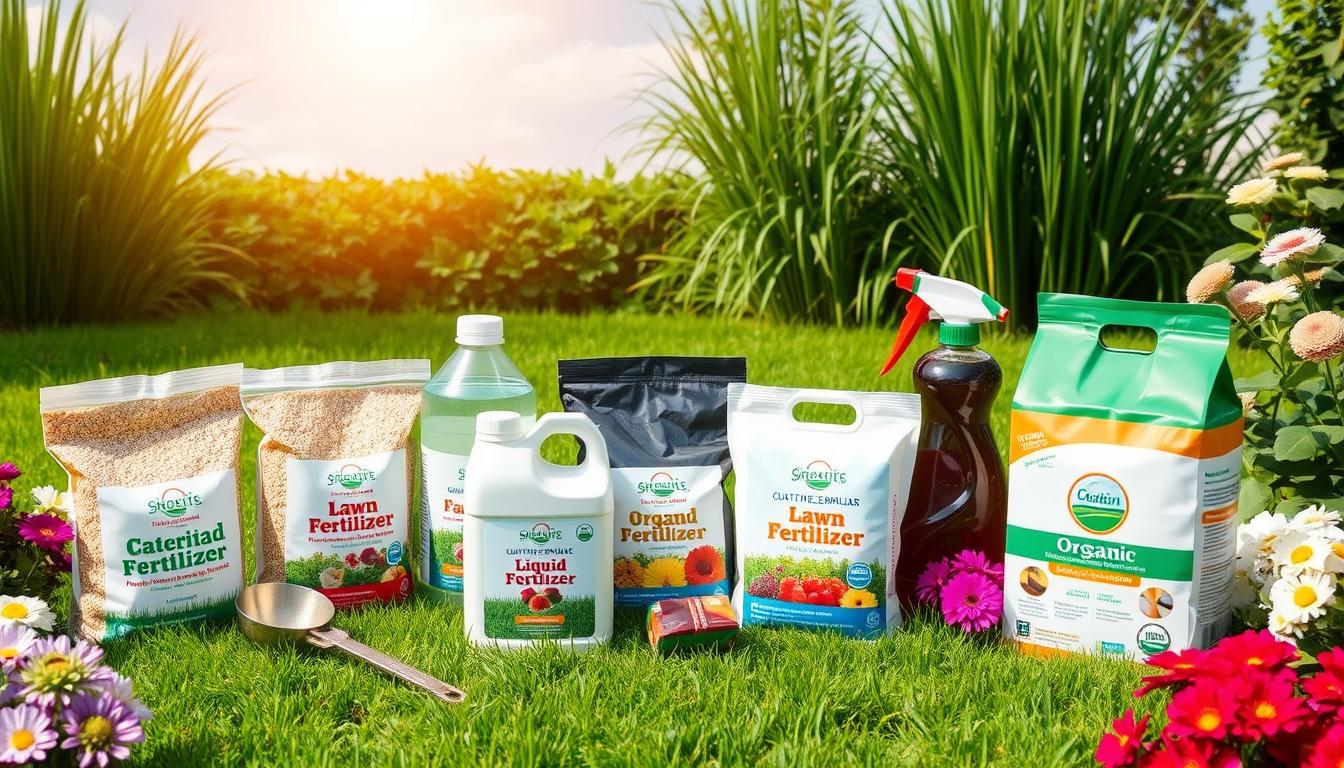
As a homeowner, I know how vital a lush, green lawn is. But did you know the right fertilizer can make a big difference? Synthetic fertilizers, making up 80% of the global market, offer quick results for a green lawn.
In this article, we’ll explore the many types of lawn fertilizers. From synthetic to organic, and from liquid to granular, we’ll cover it all. Knowing about the NPK ratio and how nutrients affect your lawn is key. This guide will help you choose the best fertilizer for your lawn, whether it’s for a quick fix, seasonal prep, or weed control.
Key Takeaways
- Synthetic fertilizers are the most affordable option, providing quick results for a green-up of the lawn.
- The NPK ratio indicates the percentage of nitrogen, phosphorus, and potassium in a fertilizer product.
- Nitrogen-based fertilizers enhance green color, leaf growth, and root development.
- Phosphate-based fertilizers promote root growth, beneficial for new lawns or poor soil.
- Potassium-based fertilizers help the lawn withstand extreme weather and stress.
Synthetic Fertilizers
Synthetic fertilizers are great for a lush, green lawn. They give your grass nitrogen, phosphorus, and potassium directly. These products work fast, making your lawn look better in days.
Nitrogen-Rich Fertilizers
Nitrogen makes your grass green and healthy. Nitrogen-rich fertilizers help your grass grow strong. But, too much can harm your lawn.
Phosphorus-Rich Fertilizers
Phosphorus-rich fertilizers strengthen your lawn’s roots. They help your grass handle drought and disease better.
Potassium-Rich Fertilizers
Potassium-rich fertilizers make your lawn more resilient. They help your grass stay healthy in tough conditions.
When picking a synthetic fertilizer, look at the NPK ratio. This ratio helps you meet your lawn’s needs.
“Synthetic fertilizers are a game-changer for my lawn, but I always make sure to follow the instructions carefully to avoid any damage. The right balance of nutrients is key to unlocking that vibrant, healthy look I’m after.”
Organic Fertilizers
As a gardener, I’ve learned a lot about organic lawn fertilizers. They’re made from plants, animals, and other organic stuff. This makes them better for the earth than synthetic fertilizers.
Organic fertilizers are slow to release nutrients. They don’t give an instant boost like chemical fertilizers. But, they help the soil over time by making it better and supporting good microbes. This slow release helps your lawn stay healthy and strong.
Also, organic fertilizers are safer for pets and people. They don’t have the bad chemicals that synthetic fertilizers do. This is great for those who care about the environment and their family’s health.
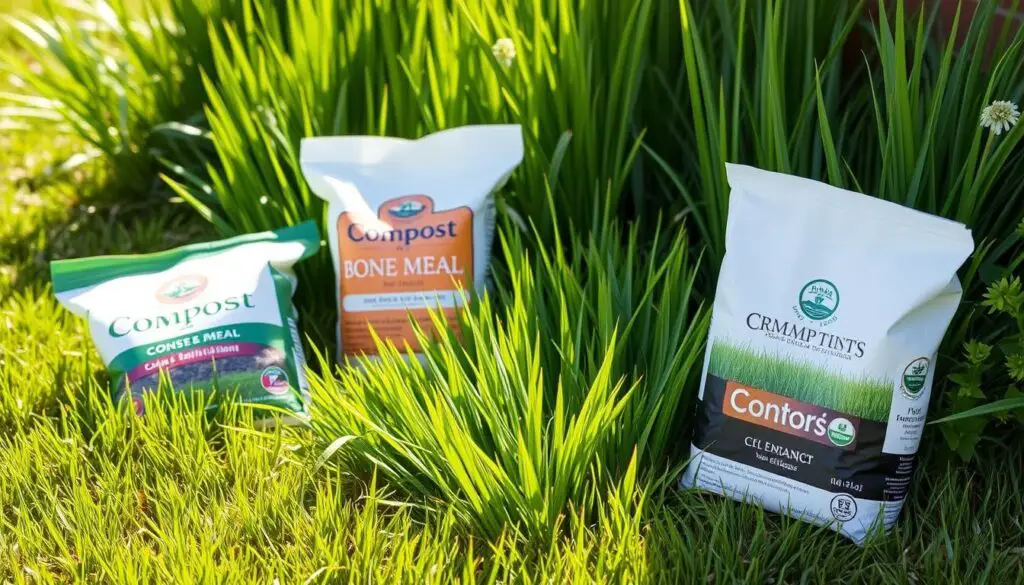
There are two main types of organic lawn fertilizers: granular and liquid. Granular ones, like Mirimichi Green’s Organic Lawn Fertilizer & Biostimulant, release nutrients slowly. Liquid ones, like Release 901C™, give a quick nutrient boost and improve soil quality.
Using organic fertilizers can really help your lawn in the long run. They make your lawn green and healthy. Plus, they help the environment by avoiding harmful chemicals.
Liquid and Fast-Acting Fertilizers
Liquid fertilizers are becoming more popular for lawn care. They come in a liquid form and are easy to use. These products are absorbed quickly by plants, giving them nutrients fast.
Using a hose-end sprayer makes applying liquid fertilizers simple. This method is great for treating specific areas of your lawn. But, it’s important to use them carefully to avoid lawn burn or uneven distribution.
| Pros of Liquid Fertilizers | Cons of Liquid Fertilizers |
|---|---|
|
|
Liquid fertilizers work fast, but they’re not the only choice. Granular fertilizers, in small pellet form, release nutrients slowly. This can lead to longer-lasting benefits. Your choice depends on your lawn’s needs, budget, and your preferences.
It’s key to follow the instructions when using fertilizers, whether liquid or granular. With the right use, both can help keep your lawn healthy and green.
“Liquid fertilizers are gaining popularity due to their fast-acting results, offering a convenient and targeted solution for lawn care enthusiasts.”
Granular and Slow-Release Fertilizers
Granular and slow-release fertilizers are key for a healthy lawn. They give nutrients slowly, keeping your lawn green and strong.
Spring Fertilizers
When spring comes, your lawn needs more nitrogen. This helps it grow and look green. Spring fertilizers are high in nitrogen, making your lawn strong and vibrant.
Using a slow-release spring fertilizer means your lawn gets nutrients for a long time. This makes your lawn more resilient.
Fall Fertilizers
In fall, your lawn focuses on getting ready for winter. Fall fertilizers have more phosphorus and potassium. These help your lawn’s roots and make it cold-tolerant.
Slow-release fall fertilizers give your lawn nutrients when it needs them most. This helps your lawn stay strong through winter.
| Fertilizer Type | Nutrient Ratio | Key Benefits |
|---|---|---|
| Spring Fertilizers | High in Nitrogen (N) | Promotes new growth and green-up |
| Fall Fertilizers | High in Phosphorus (P) and Potassium (K) | Strengthens root system and winter hardiness |
Knowing the difference between spring and fall fertilizers is important. Using slow-release options helps your lawn get the right nutrients at the right time. This keeps your lawn healthy and vibrant all year.
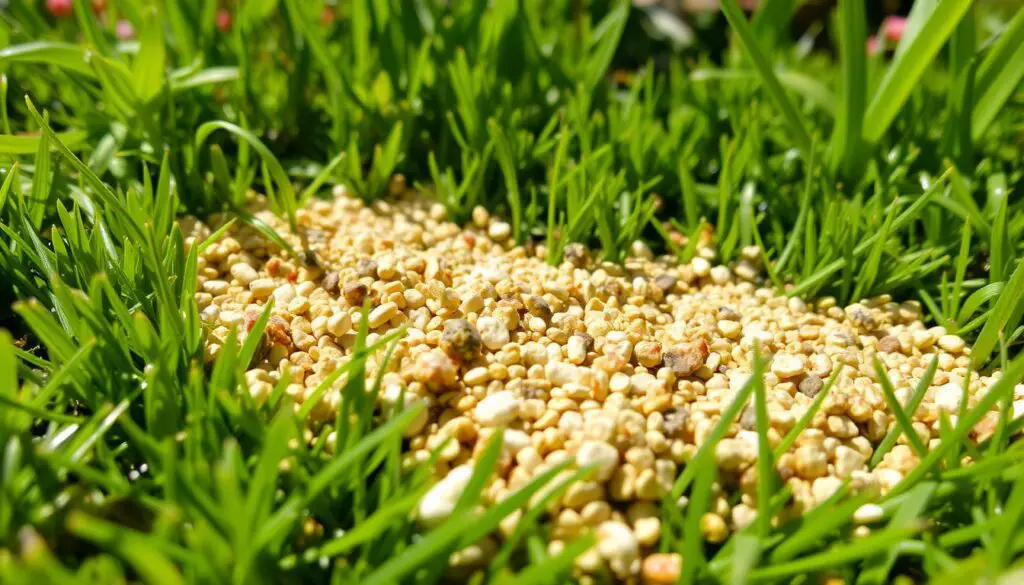
Weed and Feed Fertilizers
Keeping your lawn lush and vibrant is a delicate task. Weed and feed fertilizers offer a smart solution. They combine fertilizer and herbicide, killing weeds while feeding your grass. But, it’s important to know how to use them for the best results.
Weed and feed fertilizers kill both annual and perennial weeds. They target dandelions and clovers, and give your lawn the nutrients it needs. You can apply them in spring or fall to fight different weeds. Yet, they might not provide a balanced fertilizer and may not control grassy weeds like crabgrass well.
Using weed and feed can be risky. It might cause fertilizer burn if not applied right. Also, some herbicides, like 2,4-D, have been linked to cancer in animals. Chemical runoff from these products can also harm the environment.
| Pros of Weed and Feed | Cons of Weed and Feed |
|---|---|
|
|
For a healthier lawn, consider using pre-emergent herbicides and post-emergent herbicides. Add a balanced fertilizer regimen. Professional lawn care services like TruGreen can offer customized solutions for your lawn.
“Striking the right balance between weed control and lawn nourishment is the key to achieving a lush, vibrant outdoor space.”
Choosing weed and feed or a customized approach depends on your lawn care needs. Understanding lawn care products is key to a beautiful, healthy lawn that will impress your neighbors.
types of lawn fertilizers
Choosing the right fertilizer is key to a healthy lawn. There are many options, from all-purpose fertilizers to specialized ones. Knowing the different types can help you pick the best one for your lawn.
The 10-10-10 blend is a common all-purpose fertilizer. It has a balanced mix of nitrogen, phosphorus, and potassium. These all-purpose fertilizers are good for a general lawn care routine. Specialized fertilizers can target specific needs, like weed control or winter prep.
- Cool-season grasses, like fescue, Kentucky bluegrass, and rye, need only two fertilizers a year. One in spring and one in fall.
- Warm-season grasses, such as bahia, bermuda, centipede, St. Augustine, and zoysia, need more frequent fertilizers. Use slow-release, high-nitrogen ones every 90 to 120 days.
| Fertilizer Type | Key Characteristics |
|---|---|
| Organic | Won’t burn lawns, slow and steady nutrient release, wide range of trace minerals, balanced nutrition, and boost soil life. |
| Synthetic | Commonly available, varying formulas for specific needs, work quickly, and are inexpensive. |
| Liquid | Quick-release, easy to spray, must be reapplied more frequently but absorb quickly. |
| Granular | Slow-release, won’t need to be reapplied during the season, and provide nutrients over a long period. |
| Slow-release | Release nutrients over a controlled period, decreasing nutrient loss through soil and air, less likely to burn the lawn, and require fewer re-applications. |
| Quick-release | Provide immediate nutrients, are less expensive but more likely to burn the lawn and need frequent applications. |
Choosing the right fertilizer depends on your lawn’s size, local weather, and grass type. By picking the right types of lawn fertilizers, you can have a vibrant lawn all year round.
Biofeed Fertilizer and Little John’s Lawns
In Gilbert, Chandler, Mesa, and Queen Creek, Arizona, biofeed fertilizer is key for a lush lawn. Little John’s Lawns, a local service, uses this organic fertilizer since 2012. It feeds the soil and makes grass grow strong.
Little John’s Lawns’ fertilization program uses natural nutrients. Biofeed, a special organic fertilizer, boosts soil health and strengthens roots. It’s applied every 4 to 6 weeks to keep the grass nourished.
They also offer weed control services. They use herbicides to stop weeds from growing and kill existing ones. This way, they help customers have a weed-free, vibrant lawn.
Little John’s Lawns focuses on making customers happy. They create fertilization plans that fit each lawn’s needs. Their organic approach and success make them a top choice for lawn care.
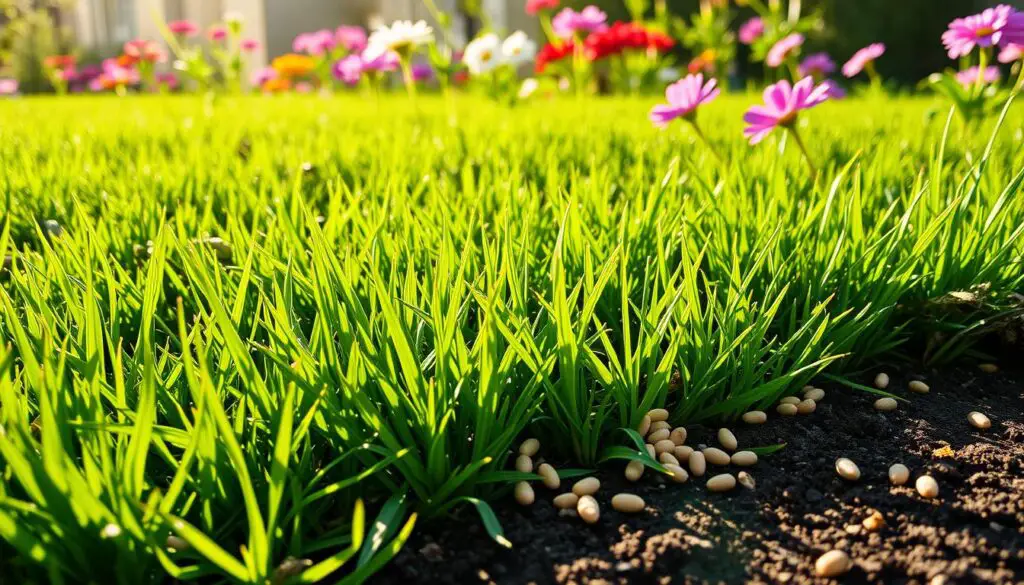
“The combination of Biofeed fertilizer and our weed control treatments has transformed our customers’ lawns into lush, vibrant, and weed-free oases.”- John, Owner of Little John’s Lawns
Fertilizers for New Lawns
Starting a new lawn can be tough, but the right fertilizers help a lot. Starter fertilizers have lots of phosphorus to help roots grow. They also have less nitrogen to avoid burning the grass. These fertilizers, like 10-10-10, 16-8-8, or 20-10-10, give new lawns the nutrients they need.
Seasonal Lawn Fertilizers
As your lawn grows, it needs different fertilizers at different times. Spring fertilizers boost growth with more nitrogen. Fall fertilizers help with phosphorus and potassium to get ready for winter.
Choosing the right fertilizer at the right time is key. Granular fertilizers should be spread evenly and mixed into the soil. Liquid fertilizers work faster but might need more frequent use.
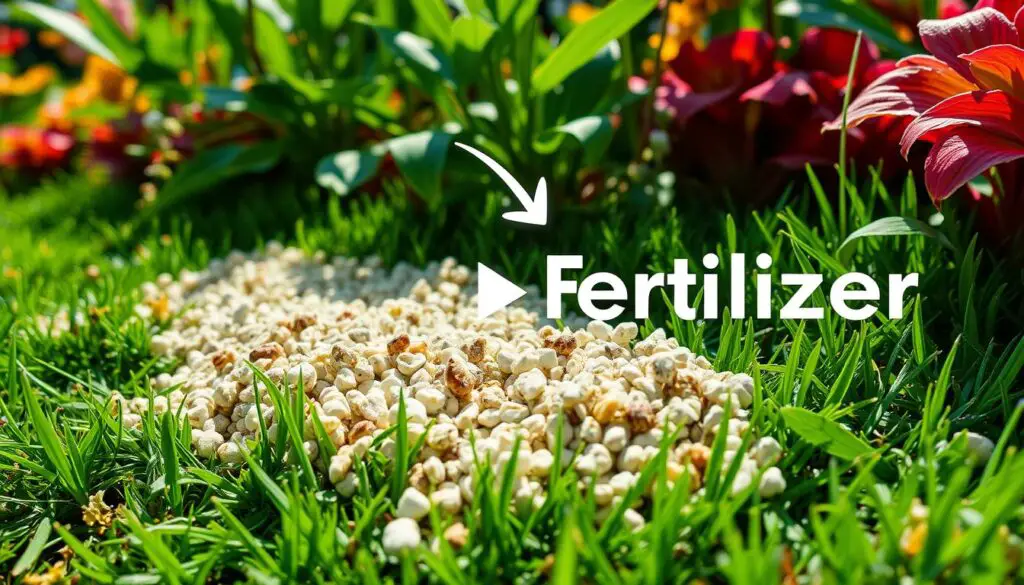
Regular care and the right fertilizers are vital for a healthy lawn. Knowing which fertilizers to use and when helps your lawn start strong and stay green for years.
Understanding Fertilizer Labels
As someone who loves their lawn, I’ve found that reading fertilizer labels is key. Every lawn fertilizer shows the amount of nitrogen (N), phosphorus (P), and potassium (K) it has. This is called the NPK ratio. It’s important because each nutrient helps your lawn grow and stay healthy.
Nitrogen makes your lawn grow fast and look green. Phosphorus helps roots grow strong. Potassium keeps plants healthy and fights off diseases. By knowing the NPK ratio, I can pick the best fertilizer for my lawn.
For example, a 16-4-8 fertilizer has 16% nitrogen, 4% phosphorus, and 8% potassium. A 10-10-10 formula has equal amounts of each. Knowing how to read these numbers has changed how I care for my lawn. Now, I can pick the best fertilizer to keep my lawn looking great all year.
FAQ
What are the different types of lawn fertilizers?
What is the difference between synthetic and organic lawn fertilizers?
What is the purpose of the NPK ratio on fertilizer labels?
What are the benefits of using liquid and granular fertilizers?
What is the purpose of weed and feed fertilizers?
What makes biofeed fertilizer unique?
How do I choose the right fertilizer for a new lawn?
Source Links
- https://www.littlejohnslawns.com/blog/types-of-lawn-fertilizers-a-comprehensive-guide
- https://www.gardeningknowhow.com/lawn-care/lgen/type-of-lawn-fertilizers.htm
- https://www.joshuatreeexperts.com/blog/what-kind-of-lawn-fertilizer-is-best-organic-synthetic-granular-liquid
- https://www.milorganite.com/lawn-care/organic-lawn-care/organic-vs-synthetic
- https://golfcourselawn.store/blogs/diy-lawn-care/best-types-of-organic-fertilizers-for-your-lawn?srsltid=AfmBOoq1Kt3ibsn_U4UtzeczF5qxdb7EFY7ScrrA0yJxpC3vXd_dyqlb
- https://naturalawn.com/inside-scoop/alternative-fertilizers
- https://myelitelawncare.com/granular-vs-liquid-fertilizer/
- https://lawnlove.com/blog/liquid-vs-granular-fertilizers/
- https://simplelawnsolutions.com/blogs/lawncare/comparing-liquid-and-granular-fertilizers?srsltid=AfmBOoonjWA5XYnNgjQ0DnPUDComzwzwNZRgKgQb0v4XHVBFYooSTEL7
- https://www.lawnandpest.net/blog/slow-release-vs-quick-release-lawn-fertilizers-pros-cons
- https://tuxedoyardcare.com/what-is-a-slow-release-fertilizer/
- https://www.heartlandturf.com/blog/weed-feed-vs-professional-lawn-fertilization
- https://todayshomeowner.com/lawn-garden/guides/weed-and-feed/
- https://www.domyown.com/weed-feed-c-59_188_410.html?srsltid=AfmBOoojq7rl_BfvJbnORLi9CVi4bTJTAkpD6uTMJhGJeSx8fX096OTv
- https://www.homedepot.com/c/ab/best-lawn-fertilizer-for-your-yard/9ba683603be9fa5395fab90df6af314
- https://earthdevelopmentinc.com/how-to-pick-the-right-fertilizer-for-your-lawn/
- https://www.littlejohnslawns.com/lawn-fertilization
- https://www.littlejohnslawns.com/weed-control
- https://lawnlove.com/blog/fertilizing-new-grass/
- https://www.lawnstarter.com/blog/lawn-care-2/how-to-choose-lawn-fertilizer/
- https://www.thespruce.com/fertilizing-new-lawn-5324851
- https://ag.umass.edu/sites/ag.umass.edu/files/fact-sheets/pdf/understanding_fertilizer_label.pdf
- https://hgic.clemson.edu/factsheet/reading-a-fertilizer-label/
- https://extension.uga.edu/publications/detail.html?number=C1058-2&title=turfgrass-fertility-understanding-fertilizer-labels-macronutrients-and-micronutrients

